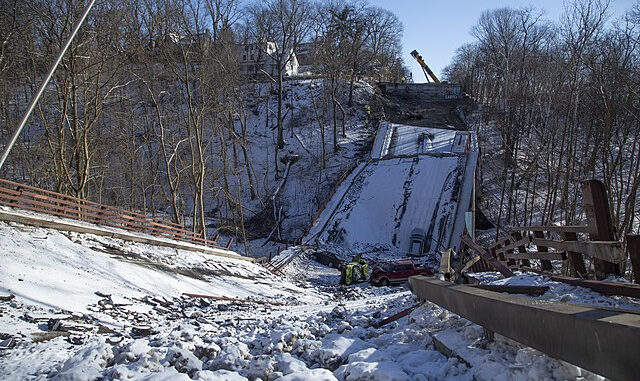
Nick Zotos | Ads Manager
London Bridge is falling down, and so is transportation infrastructure all over the United States.
Americans everywhere are recognizing a simple and obvious fact: America’s bridges are falling down, a problem made more evident following the March 26 Baltimore Key Bridge collapse after a maritime vessel collided with one of the pillars. The incident claimed the lives of six individuals while also blocking a key port for cargo transportation.
This accident underscores the need for comprehensive and bipartisan policy changes to how transportation infrastructure in our country is maintained and serviced. According to the Associated Press, about 42,000 bridges in the U.S. are in “poor” condition as defined by the National Transportation Safety Board. This is 42,000 bridges too many.
Pittsburghers are not strangers to failing infrastructure. Who can forget the infamous Greenfield Bridge under which a second, smaller bridge had to be built to prevent crumbling concrete from smashing windshields on I-376 below?`
How about the Fern Hollow Bridge, which collapsed in 2022 due to structural integrity issues? The event attracted national attention when President Joe Biden stopped at the site to promote his bipartisan “Build Back Better” legislation.
After the Fern Hollow Bridge collapsed, the National Transportation and Safety Board chair promised that with “diligent attention to inspection, maintenance and repair” our nation’s infrastructure would improve.
Since the chairperson’s comment, four bridges have collapsed, one of the worst train derailments to ever occur rocked the town of East Palestine, Ohio and the state of our nation’s highways and roads has continued to worsen.
2021 ended with a “C-” for the United States’ infrastructure rating according to the American Society of Civil Engineers four year report. To put it bluntly, the Department of Transportation and the National Transportation Safety Board are failing.
Among all the chaos, the Biden administration has recently signed the Bipartisan Infrastructure Law, approving $1.2 trillion for national transportation and infrastructure improvements. While this may seem significant, it is well below the Society of Civil Engineers’s recommendation of a $4 trillion investment for the U.S. to achieve a satisfactory “B+” rating on infrastructure.
How did we get in such a dire state? Well, money matters, but how you spend it matters more. According to the Bureau of Economic Analysis, infrastructure investment has trended down for decades, reaching all-time lows in 2020. Our politicians have been neglecting infrastructure, and the recent bridge collapse in Baltimore is not just a wake-up call, it is a catastrophic failure.
Money is not the only issue, it is also the service of railways, tunnels and bridges that must change. According to National Bridge Inspection Standards, it does not matter which state agency inspects public bridges, as long as they follow national safety guidelines. While the safety requirements for bridges in the U.S. may all be the same, the non-standardization of when and which agencies inspect or service our bridges inadvertently leads to discrepancies across the nation.
Any policy which seeks to bolster the transportation infrastructure of our country must provide guidelines for interstate agency oversight, communication and standardization to expedite the rate of maintenance and repair. A study by the Indiana Department of Transportation found that bridges should be replaced or repaired every 53 years. The average age of our country’s bridges is 42. Our bridges are aging, and our government does not have federal laws in place to maintain them fast enough. Issues in passing bipartisan infrastructure legislation stem from both sides of the aisle. The most recent bill, passed by the Biden administration, only had the support of 19 Republicans in the Senate and 13 in the House of Representatives. This reinforces the growing trend of Republicans being unwilling to increase spending into governmental projects, even if the critical funding is warranted.
However, Republicans are not the only ones to blame. With the latest bill comes Democrats tacking on other various initiatives that had nothing to do with infrastructure. Fifteen percent of the funding provided by the bill is allocated to electric vehicle integration and the systemic installment of charging stations. Another large facet of funding is dedicated to climate change concerns and the decarbonization of America’s infrastructure. This leaves only $284 billion dedicated to improving the surface transportation network.
While addressing sustainable transportation initiatives and climate change are important, they should be addressed separately to truly achieve bipartisan support.
A spokesperson for Rep. Steve Scalise, R-La, a senior Republican and vocal critic of the bill, said, “What he [the congressman] did not support is tying necessary infrastructure needs to unrelated, Green New Deal policies Democrats put in their $1.2 trillion bill — very little of which was dedicated to traditional infrastructure.”
While the merits of addressing sustainable transportation policies can be debated at another time, the congressman is right about one thing: Traditional infrastructure must be attended to with greater concern.
The president is right by saying that we need to “build back better.” However, actions speak louder than words.
Money will only be as effective as the policy changes that go with the provided resources. The United States government must take steps to ensure the safety and efficiency of transportation infrastructure in the United States. More federal governmental oversight into bridge, tunnel and rail maintenance is required. More standardization as to when and how transportation infrastructure is maintained is necessary. More funding to combat the issue is crucial. If we truly are going to “rebuild,” then we must act now. The lives of Americans depend on it.

